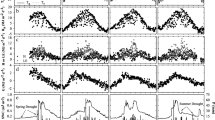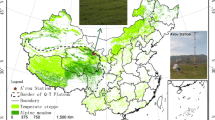Abstract
Land surface process modeling of high and cold area with vegetation cover has not yielded satisfactory results in previous applications. In this study, land surface energy budget is simulated using a land surface model for the A’rou meadow in the upper-reach area of the Heihe River Basin in the eastern Tibetan Plateau. The model performance is evaluated using the in-situ observations and remotely sensed data. Sensible and soil heat fluxes are overestimated while latent heat flux is underestimated when the default parameter setting is used. By analyzing physical and physiological processes and the sensitivities of key parameters, the inappropriate default setting of optimum growth and inhibition temperatures is identified as an important reason for the bias. The average daytime temperature during the period of fastest vegetation growth (June and July) is adopted as the optimum growth temperature, and the inhibition temperatures were adjusted using the same increment as the optimum temperature based on the temperature acclimation. These adjustments significantly reduced the biases in sensible, latent, and soil heat fluxes.
Similar content being viewed by others
References
Badger M R, Bjorkman O, Armond P A. 1982. An analysis of photosynthetic response and adaptation to temperature in higher plants: Temperature acclimation in the desert evergreen Nerium oleander L. Plant Cell Environ, 5: 85–99
Berry J, Bjorkman O. 1980. Photosynthetic response and adaptation to temperature in higher plants. Annu Rev Plant Physiol, 31: 491–543
Chen Y Y, Yang K, He J, et al. 2011. Improving land surface temperature modeling for dry land of China. J Geophys Res, 116: D20104, doi: 10.1029/2011jd015921
Chen Y Y, Yang K, Tang W J, et al. 2012. Parameterizing soil organic carbon’s impacts on soil porosity and thermal parameters for eastern Tibet grasslands. Sci China Earth Sci, 55: 1001–1011
Chen Y Y, Yang K, Zhou D, et al. 2010. Improving the Noah land surface model in arid regions with an appropriate parameterization of the thermal roughness length. J Hydrometeorol, 11: 995–1006
Crow W T, Wood E F, Pan M. 2003. Multiobjective calibration of land surface model evapotranspiration predictions using streamflow observations and spaceborne surface radiometric temperature retrievals. J Geophys Res, 108: D234725, doi: 10.1029/2002jd003292
Cui Y P. 2013. Preliminary estimation of the realistic optimum temperature for vegetation growth in China. Environ Manage, 52: 151–162
Duan Q, Sorooshian S, Gupta H V. 1992. Effective and efficient global optimization for conceptual rainfall-runoff models. Water Resour Res, 28: 1015–1031
Fan Z X, Bräuning A, Yang B, et al. 2009. Tree ring density-based summer temperature reconstruction for the central Hengduan Mountains in southern China. Glob Planet Change, 65: 1–11
Field C B, Randerson J T, Malmström C M. 1995. Global net primary production: Combining ecology and remote sensing. Remote Sens Environ, 51: 74–88
Gao Z Q, Bian L G, Cheng Y J, et al. 2002. Modeling of energy budget using Simple Biosphere Model version2 (SiB2) over Tibetan Naqu Prairie. J Appl Meterol Sci, 13: 129–141
Gao Z Q, Chae N, Kim J, et al. 2004. Modeling of surface energy partitioning, surface temperature, and soil wetness in the Tibetan prairie using the Simple Biosphere Model 2 (SiB2). J Geophys Res, 109: D06102, doi: 10.1029/2003JD004089
Gao Z Q, Chen G T J, Hu Y B. 2007. Impact of soil vertical water movement on the energy balance of different land surfaces. Int J Biometeorol, 51: 565–573
Gupta H V, Sorooshian S, Yapo P O. 1998. Toward improved calibration of hydrologic models: Multiple and noncommensurable measures of information. Water Resour Res, 34: 751–763
Hanan N P, Berry J A, Verma S B, et al. 2005. Testing a model of CO2, water and energy exchange in Great Plains tallgrass prairie and wheat ecosystems. Agric For Meteorol, 131: 162–179
Hong J, Kim J. 2010. Numerical study of surface energy partitioning on the Tibetan plateau: Comparative analysis of two biosphere models. Biogeosciences, 7: 557–568
Hu H P, Ye B S, Zhou Y H, et al. 2006. A land surface model incorporated with soil freeze/thaw and its application in GAME/Tibet. Sci China Ser D-Earth Sci, 49: 1311–1322
Koike T. 2004. The coordinated enhanced observing period-An initial step for integrated global water cycle observations. WMO Bull, 53: 115–121
Koike T, Yasunari T, Wang J, et al. 1999. GAME-Tibet IOP summary report. In: Proceedings of the First International Workshop on GAME-Tibet, Xi’an, China. 1–2
Kuczera G, Kavetski D, Renard B, et al. 2010. A limited-memory acceleration strategy for MCMC sampling in hierarchical Bayesian calibration of hydrological models. Water Resour Res, 46: W07602, doi: 10.1029/2009wr008985
Lambers H, Chapin III F S, Pons T L. 2008. Plant Physiological Ecology. New York: Springer
Li Q, Sun S F. 2008. Development of the universal and simplified soil model coupling heat and water transport. Sci China Ser D-Earth Sci, 51: 88–102
Li Q, Sun S F, Xue Y K. 2010. Analyses and development of a hierarchy of frozen soil models for cold region study. J Geophys Res, 115: D03107, doi: 10.1029/2009jd012530
Li X, Cheng G D, Liu S M, et al. 2013. Heihe Watershed Allied Telemetry Experimental Research (HiWATER): Scientific objectives and experimental design. Bull Amer Meteorol Soc, 94: 1145–1160
Li X, Koike T. 2003. Frozen soil parameterization in SiB2 and its validation with GAME-Tibet observations. Cold Reg Sci Technol, 36: 165–182
Li X, Li X W, Li Z Y, et al. 2009. Watershed allied telemetry experimental research. J Geophys Res, 114: D22103, doi: 10.1029/2008jd011590
Li Z S, Zhang Q B, Ma K P. 2012. Tree-ring reconstruction of summer temperature for A.D. 1475-2003 in the central Hengduan Mountains, Northwestern Yunnan, China. Clim Change, 110: 455–467
Liu S M, Xu Z W, Wang W Z, et al. 2011. A comparison of eddy-covariance and large aperture scintillometer measurements with respect to the energy balance closure problem. Hydrol Earth Syst Sci, 15: 1291–1306
Ma Y M, Kang S C, Zhu L P, et al. 2008. ROOF OF THE WORLD: Tibetan observation and research platform Atmosphere-Land interaction over a heterogeneous landscape. Bull Amer Meteorol Soc, 89: 1487–1492
McCabe M F, Franks S W, Kalma J D. 2005. Calibration of a land surface model using multiple data sets. J Hydrol, 302: 209–222
Prihodko L, Denning A S, Hanan N P, et al. 2008. Sensitivity, uncertainty and time dependence of parameters in a complex land surface model. Agric For Meteorol, 148: 268–287
Qiu J. 2008. China: The third pole. Nature, 454: 393–396
Rosolem R, Shuttleworth W J, Zeng X, et al. 2010. Land surface modeling inside the Biosphere 2 tropical rain forest biome. J Geophys Res, 115: G04035, doi: 10.1029/2010jg001443
Scott D. 1970. Relative growth rates under controlled temperatures of some New Zealand indigenous and introduced grasses. New Zeal J Bot, 8: 76–81
Seemann J R, Berry J A, Downton W J S. 1984. Photosynthetic response and adaptation to high temperature in desert plants. Plant Physiol, 75: 364–368
Sellers P J, Los S O, Tucker C J, et al. 1996a. A revised land surface parameterization (SiB2) for atmospheric GCMs. Part II: The generation of global field of terrestrial biophysical parameters from satellite data. J Clim, 9: 706–737
Sellers P J, Randall D A, Collatz G J, et al. 1996b. A revised land surface parameterization (SiB2) for atmospheric GCMs. Part I: Model formulation. J Clim, 9: 676–705
Sen O L, Shuttleworth W J, Yang Z L. 2000. Comparative evaluation of BATS2, BATS, and SiB2 with Amazon data. J Hydrometeorol, 1: 135–153
Song J H, Kang H S, Byun Y H, et al. 2010. Effects of the Tibetan Plateau on the Asian summer monsoon: A numerical case study using a regional climate model. Int J Climatol, 30: 743–759
Takayabu I, Takata K, Yamazaki T, et al. 2001. Comparison of the four land surface models driven by a common forcing data prepared from GAME/Tibet POP’97 products-snow accumulation and soil freezing processes. J Meteorol Soc Jpn, 79: 535–554
Troy T J, Wood E F, Sheffield J. 2008. An efficient calibration method for continental-scale land surface modeling. Water Resour Res, 44: W09411, doi: 10.1029/2007wr006513
van der Velde R, Su Z, Ek M, et al. 2009. Influence of thermodynamic soil and vegetation parameterizations on the simulation of soil temperature states and surface fluxes by the Noah LSM over a Tibetan plateau site. Hydrol Earth Syst Sci, 13: 759–777
Vrugt J A, ter Braak C J F, Clark M P, et al. 2008. Treatment of input uncertainty in hydrologic modeling: Doing hydrology backward with Markov chain Monte Carlo simulation. Water Resour Res, 44: W00B09, doi: 10.1029/2009wr008985
Wang Q J. 1991. The genetic algorithm and its application to calibrating conceptual Rainfall-Runoff Models. Water Resour Res, 27: 2467–2471
Watanabe T, Kondo J. 1990. The influence of canopy structure and density upon the mixing length within and above vegetation. J Meteorol Soc Jpn, 68: 227–235
Wilson K, Goldstein A, Falge E, et al. 2002. Energy balance closure at FLUXNET sites. Agric For Meteorol, 113: 223–243
Xu G B, Chen T, Liu X H, et al. 2011. Summer temperature variations recorded in tree-ring δ 13C values on the northeastern Tibetan Plateau. Theor Appl Climatol, 105: 51–63
Xu X D, Zhang R H, Shi X H, et al. 2008. A new integrated observational system over the Tibetan Plateau. Bull Amer Meteorol Soc, 89: 1492–1496
Yanai M, Li C F, Song Z S. 1992. Seasonal heating of the Tibetan Plateau and its effects on the evolution of the Asian summer monsoon. J Meteorol Soc Jpn, 70: 319–351
Yang K, Chen Y Y, Qin J. 2009. Some practical notes on the land surface modeling in the Tibetan Plateau. Hydrol Earth Syst Sci, 13: 687–701
Yang K, Koike T, Fujii H, et al. 2002. Improvement of surface flux parametrizations with a turbulence-related length. Q J R Meteorol Soc, 128: 2073–2087
Yang K, Koike T, Ishikawa H, et al. 2004. Analysis of the surface energy budget at a site of GAME/Tibet using a single-source model. J Meteorol Soc Jpn, 82: 131–153
Yang K, Koike T, Ye B S, et al. 2005. Inverse analysis of the role of soil vertical heterogeneity in controlling surface soil state and energy partition. J Geophys Res, 110: D08101, doi: 10.1029/2004jd005500
Yang K, Wang J M. 2008. A temperature prediction-correction method for estimating surface soil heat flux from soil temperature and moisture data. Sci China Ser D-Earth Sci, 38: 243–250
Yasunari T J, Koster R D, Lau K M, et al. 2011. Influence of dust and black carbon on the snow albedo in the NASA Goddard Earth Observing System version 5 land surface model. J Geophys Res, 116: D02210, doi: 10.1029/2010jd014861
Zhang G Z, Xu X D, Wang J Z. 2000. A dynamic study on PBL characteristics by’ 98 SCSMEX and TIPEX data. The Second Session of International Workshop on TIPEX-GAME/Tibet, Kunming, China. 58–60
Zhou D G, Huang R H. 2012. Response of water budget to recent climatic changes in the source region of the Yellow River. Chin Sci Bull, 57: 2155–2162
Zhu G F, Su Y H, Li X, et al. 2013. Estimating actual evapotranspiration from an alpine grassland on Qinghai-Tibetan plateau using a two-source model and parameter uncertainty analysis by Bayesian approach. J Hydrol, 76: 42–51
Author information
Authors and Affiliations
Corresponding authors
Rights and permissions
About this article
Cite this article
Li, Y., Sun, R. & Liu, S. Vegetation physiological parameter setting in the Simple Biosphere model 2 (SiB2) for alpine meadows in the upper reaches of Heihe river. Sci. China Earth Sci. 58, 755–769 (2015). https://doi.org/10.1007/s11430-014-4909-1
Received:
Accepted:
Published:
Issue Date:
DOI: https://doi.org/10.1007/s11430-014-4909-1




